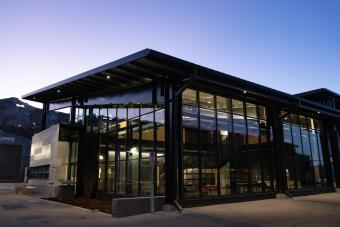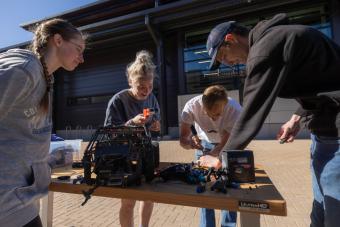With Entrepreneurship and Innovation Ecosystem, Mines ventures into new possibilities
Labriola Innovation District, Beck Venture Center are biggest physical change to Mines campus since 2018

Cornerstone Design students Philip McCuen, Angel Rocha and Jo Hearn plan and build a physical model from wood and PVC in the new Cornerstone Design Workshop inside the Labriola Innovation Hub.
Mines has long been renowned for being innovative in the classroom and research labs—a reputation built on 150 years of encouraging cutting-edge ideas, supporting bold thinking and partnering with industry to advance technology in a variety of fields. And as the school progresses into its next 150 years of producing leaders in science, technology, engineering and math, it’s providing new opportunities to help shape an innovator’s mindset and set graduates up for success in industry and business.

At the heart of these new possibilities are two new facilities—the Labriola Innovation District and the Beck Venture Center. These additions—plus the opening of McNeil Hall in 2020—are the biggest physical change to the Mines campus since the opening of the CoorsTek Center for Applied Science and Engineering in 2018.
These new spaces support the Mines Entrepreneurship and Innovation Ecosystem, with a state-of-the-art network of facilities, programs, resources and business connections for Mines students, faculty and alumni to expand their reach and impact in the world. From groundbreaking research to signature student experiences, every aspect of Mines’ academic community is dedicated to cultivating an environment where innovation thrives.
We spent some time in these spaces, learning how they are currently being used by Mines students and alumni and the possibilities they provide for the Oredigger community.
Labriola Innovation District
Mines’ state-of-the-art, hands-on, project-based learning and making headquarters, the Labriola Innovation District is a dedicated place on campus where students can innovate, prototype, work in teams and develop into future industry leaders.
The multi-building district is comprised of a variety of spaces and programs designed to support and encourage students to be innovators and entrepreneurs. The following pages showcase each component.
Labriola Innovation Hub

This 37,000-square-foot building centralizes campus makerspaces, adds specialized classrooms and incorporates much-needed student-project meeting spaces—all outfitted with the latest technology and equipment. Among the makerspaces and labs are wood and metal shops, a 3D-print and rapid prototyping makerspace, electronics lab, composites and paint shop and a tool check-out. They’re surrounded by workspace and meet-up areas where student teams—for classwork, extracurricular clubs and competitions or just for fun—can iterate together. Mines’ signature hands-on design experiences, Cornerstone and Capstone Design, also have dedicated lab spaces in the building.
The Labriola Innovation Hub is named in honor of lead donors Frank Labriola ’52 and his late wife, Mary. Frank’s generosity was driven by his passion for the entrepreneurial spirit at Mines as it helps drive the prosperity of our nation and the world.
Cornerstone Design Workshop
“The new Cornerstone Design Workshop in the recently completed Labriola Innovation Hub is a welcome and needed facility,” said Yosef Allam, director of the Cornerstone Design Program. “Students will be encouraged to work in both the dedicated Cornerstone Design Workshop, as well as other specialized fabrication shops throughout the Labriola Innovation Hub, as they explore and seek a variety of fabrication and assembly techniques to realize and continuously improve their designs to address real-world challenges and opportunities. The Labriola Innovation Hub’s expanded capacity allows for more training and curricular programming built into Cornerstone learning activities each semester, while the world-class expanded capabilities further enrich student experiences in design and better prepare students for the future.”
During the spring semester, Cornerstone Design students used the new workshop to plan and build physical models from wood and PVC to redesign existing tools in a way that makes the tools more useful and less wasteful while keeping the manufacturing process simple and inexpensive.


Thorson Design Center
“The Thorson Design Center provides a modern and fully outfitted build space for our Capstone students and their projects. We now have the workspace to support all our projects, from smaller bench-top solutions to larger footprint projects built around the periphery of the room to the garage bays that support our large automotive teams and concrete canoe team,” said Kristy Csavina, director of the Capstone Design Program. “The Labriola District is a collaborative space, and students will engage with many of the resources in their first-year design experience in Cornerstone Design. First-year students will now see the seniors working on more advanced projects and see the projects and opportunities available to them in their senior year.”


xWorks Innovation Space
Next door to the Labriola Innovation Hub, the xWorks Innovation Space include 13 large-scale building bays for larger projects, such as the SAE Formula I race car teams and gas-to-electric car conversion senior design teams. It also includes a state-of-the-art Engines & Testing Lab, where students can work on traditional and alternative engines research.
“The Labriola Innovation District, including the xWorks Labs, embodies Mines’ commitment to hands-on learning experiences. These spaces prepare Mines students to tackle the real, open-ended challenges they’ll face in their careers, making their education more relevant and impactful,” said Polina Ringler, assistant teaching professor of mechanical engineering. “We’re incredibly excited about having our automotive program situated in this dynamic setting. It enables us to provide a collaborative atmosphere and gives our students access to cutting-edge spaces and tools as they bridge the gap between theory and practical application.”
Pictured here are students working in the xWorks Innovation Space on an Introduction to Automotive Design class project that involves modifying a 1/6-scale remote control car for a drag race. The course focuses on system-level engineering, requirements-based design and road-load estimation and characterization. The students practice class concepts through modeling and design projects and then get hands-on experience implementing and testing their solutions in the lab component.


McNeil Hall
McNeil Hall houses state-of-the-art project-based learning classrooms, largely dedicated to first-year design challenge classes. Students learn how to advance their ideas from problem to concept to prototype and, finally, to product or startup. It hosted its first classes in September 2020.
McNeil Hall was named in honor of Charles “Charlie” McNeil ’71 and his wife, Judy. The McNeils believe in entrepreneurship as a means to professional and personal success and want to ensure every Mines student has the opportunity to learn and grow through entrepreneurial instruction and hands-on experiences.

Beck Venture Center

The other half of the Entrepreneurship and Innovation Ecosystem is the Beck Venture Center. This facility combines unique spaces, supportive programming and rich resources designed to help Mines students, faculty and alumni successfully launch companies based on their breakthrough ideas, solutions and technologies, particularly those coming from the activities in the Labriola Innovation District.
The 31,000-square-foot coworking, event and innovation space is designed for entrepreneurs, investors, mentors, companies and students to connect and collaborate. The café and coworking space can accommodate up to 300 people who are developing their ideas, while the classroom and meeting spaces are suited for teaching the next generation of entrepreneurs.
Inside the Beck Venture Center, the Mines Venture Program provides support for Mines-affiliated startups to launch. Some highlights of the program include organizing and coordinating a world-class network of mentors and advisors, twice-a-year “look books” and demo days to showcase startups to the investor community, support from a highly curated network of service providers, and regular educational and networking programs.
The Beck Venture Center is named for lead donors Mike and Kelly Beck, the parents of two Mines alums. The Becks saw the growing Entrepreneurship and Innovation Ecosystem at Mines and designated their gift to catalyze the vision of turning student and faculty innovations into successful products and companies.

James Bauer ’19, MS ’21 is the founder and CEO of Venvee, a spatial artificial intelligence company that provides retail spaces with an end-to-end understanding of an in-store shopper’s experience from entry to exit. Venvee was born out of and supported by the Mines Venture Program.
We asked Bauer about what it was like to be supported by the Mines Venture Program and the opportunities he gained through the experience of pursuing his ideas at Mines in this way.
Mines Magazine: How did Venvee come about, and how did the Venture Program support your initial development?
Bauer: Venvee evolved through a series of iterations driven by continuous learning. Like many companies, our initial concept isn’t our current one. The Venture Program provided invaluable lessons in problem validation. A common pitfall for first-time entrepreneurs is focusing on a solution rather than identifying the problem, which is where my journey began. In 2021, the leaders of the Venture Program emphasized the importance of centering the problem and taught me strategies to confirm its existence. They only began teaching me “solution validation” once they were confident I had properly validated the problem. As we continued to understand where problems were, we were able to iterate on the value we intended to bring to the world.
MM: Why did you want to start your own business?
Bauer: I’ve always been drawn to efforts that have no ceiling, where the height it could go was directly related to my personal ability to achieve. However, after a brief unsuccessful stint in conventional employment, I felt a disconnection between my ambition to rise and the limitations of a traditional career path. While this isn’t universally true, I was discouraged by the idea of trying it again and instead wanted to see how far I could get on my own.
MM: How do you think your business would be different if you didn’t have the support of the Venture Program and the entrepreneurship and innovation programming Mines now offers?
Bauer: Without the Mines Venture Program, Venvee wouldn’t exist. I wasn’t on a path to success independently, and the Venture Program helped me find the right direction and take my first steps toward building a successful business. Similarly, without the alumni network, Venvee would not exist. My commitment and determination were met by other Mines alumni with abundant entrepreneurial support, along with our initial equity-based financings.
MM: How do you think these new spaces on campus, like the Beck Venture Center, will provide more possibilities for what Mines students and graduates are able to accomplish, either as entrepreneurs or
in general?
Bauer: These new spaces will foster industry-altering businesses and produce global innovators. Mines has always been home to some of the brightest minds in the world. By pairing these minds with resources to pursue their intellectual curiosities limitlessly, Mines will change the world.




